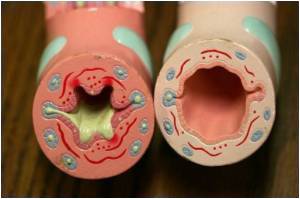A molecule's previously unknown role as a major trigger for airway remodeling, which impairs lung function has been discovered by Michael Croft

"Dr. Croft's continued efforts to uncover the cellular pathways influencing asthma and other lung disorders have produced remarkable results," said Mitchell Kronenberg, Ph.D., La Jolla Institute president and chief scientific officer. "He is a researcher of the highest caliber and I believe his discoveries will someday improve the lives of millions of people around the world."
In his Nature Medicine paper entitled, "The tumor necrosis factor family member LIGHT is a target for asthmatic airway remodeling," Dr. Croft showed that blocking LIGHT's interactions with its two receptors significantly inhibited the process of airway remodeling in mouse models of chronic asthma. Airway remodeling refers to inflammation-fueled structural changes in the lungs, including fibrosis, which can occur over time and result in declining lung function that strongly contributes to conditions such as COPD, chronic asthma, and several other respiratory disorders.
Asthma affects more than 20 million Americans, including nine million children, and is the third-ranking cause of hospitalization among U.S. children under age 15. According to federal officials, asthma results in $14 billion annually in U.S. health care costs. COPD is one of the most common lung diseases and comes in two main forms, chronic bronchitis and emphysema. More than 12 million Americans have been diagnosed with COPD, which is a major cause of disability and the fourth leading cause of death in the United States.
Current therapies for asthma and COPD primarily include corticosteroids, bronchodilators, and leukotriene antagonists, but these are thought to have little impact, if any, on airway remodeling, said Dr. Croft.
Dr. Croft said emerging data on the role of the tumor necrosis factor (TNF) super family of molecules in fueling inflammatory diseases, including his own finding on OX40 Ligand and its receptor's action in triggering inflammation in asthma, prompted him to take a close look at fellow TNF molecule, LIGHT. "We hypothesized that LIGHT might be involved in driving aspects of lung inflammation or have a role in lung dysfunction that was different than our previous findings on OX40L," he said. "As we were undertaking our studies, a report found that increased sputum LIGHT levels in people with asthma correlated with decreased lung function, which was in line with our thinking."
Advertisement
In a related finding, published March 14 in the Journal of Experimental Medicine, Dr. Croft also showed a connection between LIGHT and T cell-fueled inflammation that contributes to other aspects of asthmatic disease. "We showed that blocking LIGHT binding to one of its receptors, named the herpesvirus entry mediator, reduced the ability of T lymphocytes, induced with a model allergen, to survive long-term. This strongly curtailed lung inflammation associated with asthma when the allergen was subsequently inhaled," he said. The findings were detailed in a scientific paper entitled, "Herpesvirus entry mediator (TNFRSF14) regulates the persistence of T helper memory cell populations."
Advertisement
LIGHT was initially discovered in 1998 by former La Jolla Institute scientist Carl Ware, Ph.D. The TNF family of molecules has proven to be important players in inflammation-driven autoimmune diseases and is a particular focus of the La Jolla Institute.
"The fact that LIGHT appears to be important in Crohn's disease and colitis, and now may have an indication in asthma, is a continued demonstration of the TNF family's critical role in inflammatory diseases," said Dr. Kronenberg. "We are thrilled that both of these findings originated from our Institute. It is a reflection that our Institute is one of the world's leaders in TNF research, which is a hotbed of therapeutic potential for autoimmune diseases."
Source-Eurekalert













